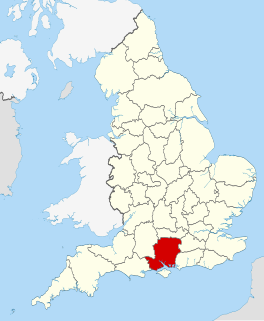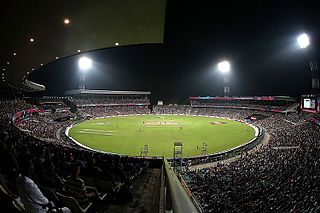
Hampshire County Cricket Club is one of eighteen first-class county clubs within the domestic cricket structure of England and Wales. It represents the historic county of Hampshire. Hampshire teams formed by earlier organisations, principally the Hambledon Club, always had first-class status and the same applied to the county club when it was founded in 1863. Because of poor performances for several seasons until 1885, Hampshire then lost its status for nine seasons until it was invited into the County Championship in 1895, since when the team have played in every top-level domestic cricket competition in England. Hampshire originally played at the Antelope Ground, Southampton until 1885 when they relocated to the County Ground, Southampton until 2000, before moving to the purpose-built Rose Bowl in West End, which is in the Borough of Eastleigh. The club has twice won the County Championship, in the 1961 and 1973 seasons.
The Hambledon Club was a social club that is famous for its organisation of 18th century cricket matches. By the late 1770s it was the foremost cricket club in England.
John Small was an English professional cricketer who played from about 1756 to 1798, one of the longest careers on record. Born at Empshott, Hampshire, he is generally regarded as the greatest batsman of the 18th century and acknowledged as having been the first to master the use of the modern straight bat which was introduced in the 1760s. He scored the earliest known century in important cricket. He died at Petersfield, where he was in residence for most of his life and where he established businesses.

Broadhalfpenny Down is a historic cricket ground in Hambledon, Hampshire. It is known as the "Cradle of Cricket" because it was the home venue in the 18th century of the Hambledon Club, but cricket predated the club and ground by at least two centuries. The club is in the parish of Hambledon close to the neighbouring parish of Clanfield. The club took the name of the neighbouring rural village of Hambledon, situated about 2.7 away miles by road.
Richard "Dick" Nyren (c. 1734–1797) was an English professional cricketer who played first-class cricket during the 1760s and 1770s in the heyday of the Hambledon Club. A genuine all-rounder and the earliest known left-hander of note, Nyren was the captain of Hampshire when its team included players like John Small, Thomas Brett and Tom Sueter. Although the records of many matches in which he almost certainly played have been lost, he made 51 known appearances between 1764 and 1784. He was known as the team's "general" on the field and, for a time, acted as the club secretary as well as taking care of matchday catering for many years.
The 1768 English cricket season was the 25th season following the earliest known codification of the Laws of Cricket. Details have survived of nine eleven-a-side matches between significant teams.
The 1769 English cricket season was the 26th season following the earliest known codification of the Laws of Cricket. Details have survived of 11 eleven-a-side matches between significant teams. It was the last season in which the original London Cricket Club and the Artillery Ground featured prominently.
The 1772 English cricket season was the 29th season following the earliest known codification of the Laws of Cricket and the first in which matches have been awarded retrospective first-class cricket status. Details have survived of three first-class matches, all featuring Hampshire sides playing England XIs.
The 1766 English cricket season was the 23rd season following the earliest known codification of the Laws of Cricket. Details have survived of three eleven-a-side matches between significant teams.
John Bayton was an English professional cricketer who played first-class cricket during the 1760s and 1770s.
Thomas Sueter was an English cricketer who represented Hampshire as a member of the Hambledon Club.
Hampshire county cricket teams have been traced back to the 18th century but the county's involvement in cricket goes back much further than that. Given that the first definite mention of cricket anywhere in the world is dated c.1550 in Guildford, in neighbouring Surrey, it is almost certain that the game had reached Hampshire by the 16th century.
The 1764 English cricket season was the 21st season following the earliest known codification of the Laws of Cricket. Details have survived of seven eleven-a-side matches between significant teams.
The 1767 English cricket season was the 24th season following the earliest known codification of the Laws of Cricket. Details have survived of seven eleven-a-side matches between significant teams.
The 1771 English cricket season was the 28th season following the earliest known codification of the Laws of Cricket. Details have survived of 19 eleven-a-side matches between significant teams. The Monster Bat Incident occurred during the season.
Itchin Stoke Down is a rural location near the town of Alresford in Hampshire. It was used as a venue for 13 first-class cricket matches between 1778 and 1806 and as the home of the Alresford Cricket Club.
Windmill Down is a rural location near the town of Hambledon in Hampshire. From 1782 to 1795, it was the home of the Hambledon Club as a noted cricket venue.
Andrew Freemantle was an English cricketer who played for Hampshire during the Hambledon Era and afterwards. He was a left-handed batsman, a noted fielder and an occasional wicket-keeper.
Cheden Holt, situated on a hilltop about a mile from the rural village of Hambledon in Hampshire, was a home venue of the Hambledon Club. It was used for a single first-class cricket match in 1776, when a Hampshire side played a Kent team. This is the only important match played at the ground, with no further mention of any other matches after 1776.




